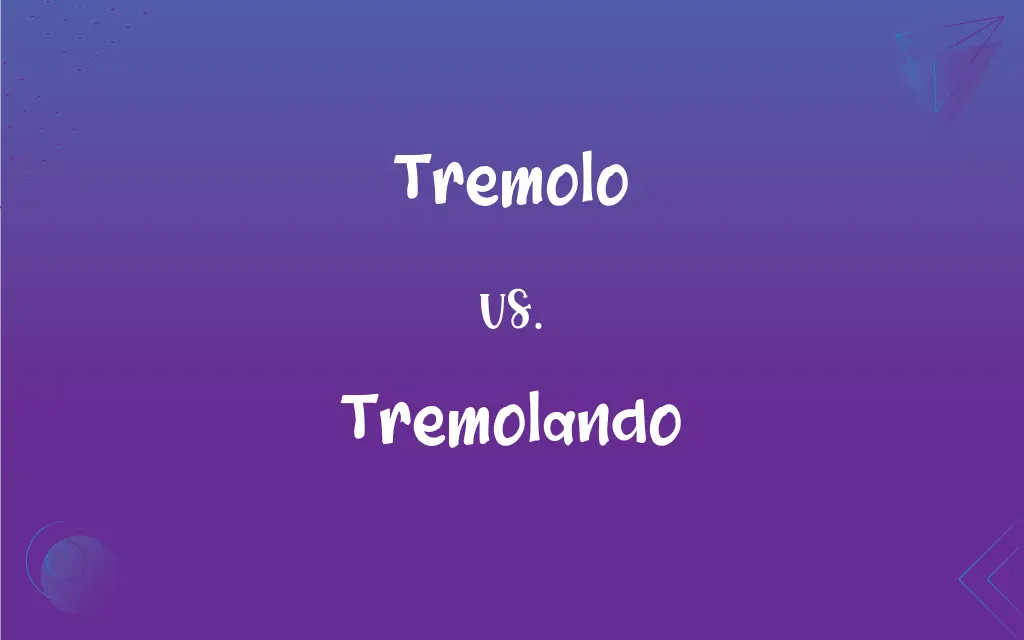Tremolo vs. Tremolando: What's the Difference?
By Aimie Carlson || Updated on May 22, 2024
Tremolo is a rapid repetition of a single note or alternation between two notes, creating a shaking effect. Tremolando, often synonymous with tremolo, generally refers to a broader, more continuous trembling or quivering effect.

Key Differences
Tremolo is a musical technique where a single note is rapidly repeated or where two notes are quickly alternated, producing a quivering sound. Tremolando, while often used interchangeably with tremolo, tends to imply a more extended and continuous trembling effect over a passage rather than on a single note.
Tremolo can be executed on various instruments, notably string instruments and keyboards, by quickly moving the bow or fingers. Tremolando, on the other hand, is more commonly associated with creating an atmospheric, wavering sound, particularly in orchestral or ensemble settings.
In notation, tremolo is typically indicated by slashes through the stem of a note or notes, while tremolando might be written as an instruction above the music, guiding performers to maintain a trembling effect over a series of notes or a passage.
Tremolo focuses on the rapid repetition or alternation to achieve its effect. Tremolando emphasizes sustaining this effect over a longer duration, often contributing to a more dramatic or intense musical atmosphere.
The primary difference lies in their application and duration: tremolo is often more rhythmic and precise, whereas tremolando aims for a continuous, flowing quiver that can span several measures or an entire piece.
ADVERTISEMENT
Comparison Chart
Definition
Rapid repetition or alternation of notes
Continuous trembling effect
Notation
Slashes through note stems
Instruction above the music
Duration
Shorter, precise bursts
Extended, flowing quivers
Common Usage
String instruments, keyboards
Orchestral, ensemble settings
Primary Focus
Rhythmic precision
Sustained atmosphere
ADVERTISEMENT
Tremolo and Tremolando Definitions
Tremolo
Technique creating a shaking effect.
The guitarist's tremolo enhanced the emotional impact.
Tremolando
Continuous trembling effect.
The conductor asked for a tremolando to sustain the tension.
Tremolo
Notated with slashes through note stems.
The sheet music indicated tremolo with three slashes.
Tremolando
Often used in orchestral music.
The strings played a tremolando to create an eerie atmosphere.
Tremolo
Commonly used in classical and rock music.
The rock band's song featured an energetic tremolo.
Tremolando
Indicated by written instructions.
The score directed the musicians to perform a tremolando.
Tremolo
A tremulous effect produced by rapid repetition of a single tone or by rapid alternation of two tones.
Tremolando
Adds a dramatic or intense sound.
The composer used tremolando to heighten the climax.
Tremolo
A device on an organ for producing a tremulous effect.
Tremolando
Spans longer durations than tremolo.
The tremolando extended through the entire phrase.
Tremolo
Vibrato, especially in singing.
Tremolando
(music) A tremolo section of a piece.
Tremolo
(music) A rapid repetition of the same note, or an alternation between two or more notes. It can also be intended to mean a rapid and repetitive variation in pitch for the duration of a note. It is notated by a strong diagonal bar across the note stem, or a detached bar for a set of notes (or stemless notes).
Tremolando
(music) Played with a tremolo effect.
Tremolo
(music) A variation in the volume of a note or a chord, evoking a tremor or quiver.
Tremolando
Same as Tremando.
Tremolo
(music) The device in an organ that produces a tremolo effect.
Tremolo
The rapid reiteration of tones without any apparent cessation, so as to produce a tremulous effect.
Tremolo
(music) a tremulous effect produced by rapid repetition of a single tone or rapid alternation of two tones
Tremolo
Vocal vibrato especially an excessive or poorly controlled one
Tremolo
Rapid repetition of a single note.
The violinist played a tremolo to add intensity.
Tremolo
Quick alternation between two notes.
The tremolo between C and G added a vibrant texture.
FAQs
Is tremolando the same as tremolo?
They are similar, but tremolando implies a more extended and atmospheric effect.
Does tremolando require special technique?
Yes, musicians need to sustain a continuous trembling sound over longer passages.
What is a tremolo in music?
Tremolo is the rapid repetition or alternation of a note or notes to create a shaking sound.
What is tremolando?
Tremolando is a continuous trembling effect in music, creating a wavering sound.
Can tremolo be performed on all instruments?
Yes, but it is most commonly used on string instruments and keyboards.
Does tremolo always involve rapid speed?
Yes, the essence of tremolo is its rapid repetition or alternation.
How is tremolo notated in sheet music?
Tremolo is notated with slashes through the stems of the notes.
What effect does tremolo have in music?
Tremolo adds intensity and vibrancy through rapid note repetition.
Can tremolo be played on a piano?
Yes, piano tremolo involves quickly alternating between two notes.
Is tremolo used in modern music?
Yes, tremolo is used in various modern music styles for dramatic effects.
How does tremolando affect the dynamics of a piece?
Tremolando can significantly enhance the emotional intensity and dynamic range.
Is tremolo harder to perform than tremolando?
Difficulty varies by instrument and context, but both require skill and practice.
What kind of mood does tremolando create?
Tremolando creates an atmospheric, often intense mood in music.
How do you indicate tremolando in music notation?
Tremolando is often indicated by written instructions above the music.
Where is tremolando commonly used?
Tremolando is commonly used in orchestral and ensemble music for dramatic effects.
How long can a tremolo last?
Tremolo can last for short, precise bursts, often within a single measure.
Are there different types of tremolo?
Yes, including finger tremolo on string instruments and bowed tremolo.
What is the historical origin of tremolo?
Tremolo has roots in classical music and has evolved across various genres.
What type of music features tremolo?
Tremolo is featured in classical, rock, and various other music genres.
Can tremolando span multiple measures?
Yes, tremolando can extend across several measures or entire passages.
About Author
Written by
Aimie CarlsonAimie Carlson, holding a master's degree in English literature, is a fervent English language enthusiast. She lends her writing talents to Difference Wiki, a prominent website that specializes in comparisons, offering readers insightful analyses that both captivate and inform.
































































